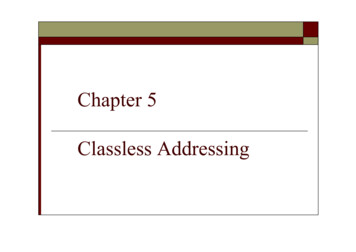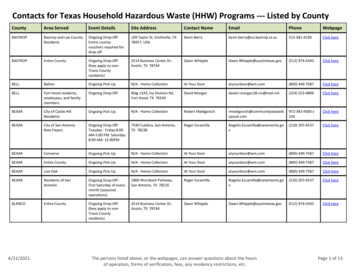
Transcription
CHAPTER 5The PeriodicLawOnline ChemistryHMDScience.comSection 2Electron Configuration andthe Periodic TableSection 3Electron Configuration andPeriodic PropertiesOnline Labs include:The Mendeleev Lab of 1869Reactivity of Halide IonsPeriodicity of Properties ofOxidesExploring the Periodic TablePremium ContentWhy It Matters VideoHMDScience.comPeriodic Law(c) NOAO/Photo Researchers, IncSection 1History of the PeriodicTable
Section 1History of thePeriodic TableMain IdeasMendeleev’s periodic tablegrouped elements by theirproperties.Moseley arranged elements bytheir atomic numbers.Key Termsperiodic lawperiodic tablelanthanideactinideImagine the confusion among chemists during the middle of the nineteenth century.By 1860, more than 60 elements had been discovered. Chemists had to learnthe properties of these elements as well as those of the many compounds thatthey formed—a difficult task. And to make matters worse, there was no methodfor accurately determining an element’s atomic mass or the number of atoms ofan element in a particular chemical compound. Different chemists used differentatomic masses for the same elements, resulting in different compositions beingproposed for the same compounds. This made it nearly impossible for one chemistto understand the results of another.In September 1860, a group of chemists assembled at the First InternationalCongress of Chemists in Karlsruhe, Germany, to settle the issue of atomic massas well as some other matters that were making communication difficult. At theCongress, Italian chemist Stanislao Cannizzaro presented a convincing method foraccurately measuring the relative masses of atoms. Cannizzaro’s method enabledchemists to agree on standard values for atomic mass and initiated a search forrelationships between atomic mass and other properties of the elements.Modern periodic tables arrangethe elements by both atomicnumber and properties. Virginia standardsCH.1.i The student will investigate andunderstand that experiments in which variablesare measured, analyzed, and evaluatedproduce observations and verifiable data. Keyconcepts include: construction and defense ofa scientific viewpoint.CH.1.EKS-26, CH.2.EKS-16Main IdeaMendeleev’s periodic table grouped elements by theirproperties.When the Russian chemist Dmitri Mendeleev heard about the newatomic masses discussed at Karlsruhe, he decided to include the newvalues in a chemistry textbook he was writing. In the book, Mendeleevhoped to organize the elements according to their properties. He wentabout this much as you might organize information for a research paper.He placed the name of each known element on a card, together with theatomic mass of the element and a list of its observed physical and chemical properties. He then arranged the cards according to various propertiesand looked for trends or p atterns.Figure 1.1Periodic Patterns The regularlyspaced water waves represent asimple periodic pattern.critical thinkingRelate Why are regularly-spacedwater waves referred to as aperiodic pattern? SuperStockMendeleev noticed that when the elements were arranged in order ofincreasing atomic mass, certain similarities in their chemical propertiesappeared at regular intervals. Such a repeating pattern is referred to asperiodic. The second hand of a watch, for example, passes over any givenmark at periodic, 60 - second intervals. The circular waves created by adrop of water hitting a water surface, as shown in Figure 1.1, are alsoperiodic.The Periodic Law125
Figure 1.2Mendeleev’s First PeriodicTable In his first published periodictable, Mendeleev arranged the elementsin vertical periods according to relativeatomic mass. The atomic mass for eachelement is indicated by the numberfollowing the element’s symbol. Theunknown elements indicated by questionmarks at estimated atomic masses 45, 68,and 70 were later identified as scandium,Sc;gallium, Ga, and germanium, Ge.Mendeleev created a table in which elements with similar propertieswere grouped together—a periodic table of the elements. His firstperiodic table, shown in Figure 1.2, was published in 1 869. Note thatMendeleev placed iodine, I (atomic mass 127), after tellurium,Te (atomic mass 128). Although this contradicted the pattern of listingthe elements in order of increasing atomic mass, it allowed Mendeleevto place tellurium in a group of elements with which it shares similarproperties. Reading horizontally across Mendeleev’s table, this groupincludes oxygen, O; sulfur, S; and selenium, Se. Iodine could also then beplaced in the group it resembles chemically, which includes fluorine, F,chlorine, Cl, and bromine, Br.Mendeleev’s procedure left several empty spaces in his periodictable (see Figure 1.2). In 1871, the Russian chemist boldly predicted theexistence and properties of the elements that would fill three of thespaces. By 1886, all three elements had been discovered. Today theseelements are known as scandium, Sc, gallium, Ga; and germanium, Ge.Their properties are strikingly similar to those predicted by Mendeleev.The success of Mendeleev’s predictions persuaded most chemists toaccept his periodic table and earned him credit as the discoverer of theperiodic law. Two questions remained, however. (1) Why could most ofthe elements be arranged in the order of increasing atomic mass, but afew could not? (2) What was the reason for chemical periodicity?126Chapter 5
Main IdeaMoseley arranged elements by their atomic numbers.The first question was not answered until more than 40 years afterMendeleev’s first periodic table was published. In 1911, the Englishscientist Henry Moseley, who was working with Ernest Rutherford,examined the spectra of 38 different metals. When analyzing his data,Moseley discovered a previously unrecognized pattern. The elementsin the periodic table fit into patterns better when they were arranged inincreasing order according to nuclear charge, or the number of protonsin the nucleus. Moseley’s work led to both the modern definition ofatomic number and the recognition that atomic number, not atomicmass, is the basis for the organization of the periodic t able.Moseley’s discovery was consistent with Mendeleev’s ordering of theperiodic table by properties rather than strictly by atomic mass. Forexample, according to Moseley, tellurium, with an atomic number of 52,belongs before iodine, which has an atomic number of 53. Today,Mendeleev’s principle of chemical periodicity is correctly stated in what isknown as the periodic law: The physical and chemical properties of theelements are periodic functions of their atomic numbers. In other words,when the elements are arranged in order of increasing atomic number,elements with similar properties appear at regular intervals.Main IdeaModern periodic tables arrange the elements by bothatomic number and properties.The periodic table has undergone extensive change since Mendeleev’stime. Chemists have discovered new elements and, in more recent years,synthesized new ones in the lab oratory. Each of the more than 40 newelements, however, can be placed in a group of other elements withsimilar properties. The periodic table is an arrangement of the elements inorder of their a tomic numbers so that elements with similar properties fall inthe same column, or g roup.The Noble GasesPerhaps the most significant addition to the periodic table came withthe discovery of the noble gases. In 1894, English physicist John WilliamStrutt (Lord Rayleigh) and Scottish chemist Sir William Ramsay discoveredargon, Ar, a gas in the atmosphere that had previously escaped noticebecause of its total lack of chemical reactivity. Back in 1868 another noblegas, helium, He, had been discovered as a component of the sun. In 1895,Ramsay showed that helium also exists on Earth.In order to fit argon and helium into the periodic table, Ramsayproposed a new group (see Figure 1.3). He placed this group betweenthe groups now known as Group 17 (the fluorine family) and Group 1(the lithium family). In 1898, Ramsay discovered two more noble gases,krypton, Kr, and xenon, Xe. The final noble gas, radon, Rn, was discovered in 1900 by the German scientist Friedrich Ernst D orn.Figure 1.3Noble Gases The noble gases, alsoknown as the Group 18 elements, are allrather unreactive. As you will read, thereason for this low reactiv ity also accountsfor the special place occupied by the noblegases in the periodic 1525354SbTeIXe83848586BiPoAtRnThe Periodic Law127
The LanthanidesThe next step in the development of the periodic table was completed inthe early 1900s. It was then that the puzzling chemistry of the lanthanideswas finally understood. The lanthanides are the 14 elements with atomicnumbers from 58 (cerium, Ce) to 71 (lutetium, Lu). Because these elements areso similar in chemical and physical properties, the process of separating andidentifying them was a tedious task that required the effort of many chemists.The ActinidesAnother major step in the development of the periodic table was thediscovery of the actinides. The actinides are the 14 elements with atomicnumbers from 90 (thorium, Th) to 103 (lawrencium, Lr). The lanthanides andactinides belong in Periods 6 and 7, respectively, of the periodic table,between the elements of Groups 3 and 4. To save space, the lanthanides andactinides are usually set off below the main portion of the periodic table.designing your own periodic tableQuestionCan you design your own periodictable using information similar tothat available to M endeleev?Procedure1. Write down the informationavailable for each element onseparate index cards. Thefollowing information is appro priate: a letter of the alphabet(A, B, C, etc.) to identify eachelement; atomic mass; state;density; melting point; boilingpoint; and any other readilyobservable p hysical properties.Do not write the name of theelement on the index card, butkeep a separate list indicatingthe letter you have assignedto each e lement.2. Organize the cards for theelements in a logical patternas you think Mendeleev mighthave d one.128Chapter 5Discussion1. Keeping in mind that theinformation you have is similarto that available to Mendeleevin 1869, answer the following questions.a. Why are atomic massesgiven instead of atomic numbers?b. C an you identify eachelement by name?2. How many groups of elements,or families, are in your periodictable? How many periods, orseries, are in the table?3. Predict the characteristics ofany missing elements. Whenyou have finished, check yourwork using your separate list ofelements and a periodic table.Materials index cards
PeriodicityFigure 1.4Periodicity with respect to atomic number can be observed in any groupof elements in the periodic table. For example, consider the noble gasesof Group 18. The first noble gas is helium, He. Helium has an atomicnumber of 2. The elements following helium in atomic number havecompletely different properties until the next noble gas, neon, Ne, isreached. Neon has an atomic number of 10. The remaining noble gasesin order of increasing atomic number are argon (Ar, atomic number 18),krypton (Kr, atomic number 36), xenon (Xe, atomic number 54), andradon (Rn, atomic number 86). Thus, the differences in atomic numberbetween successive noble gases are 8, 8, 18, 18, and 32, as shown inPatterns in the Periodic TableIn each of Groups 1 and 18, thedifferences between the atomic numbersof successive elements are 8, 8, 18, 18,and 32, respectively. Groups 2 and 13–17follow a similar pattern.Elementand atomicnumberHeFigure 1.4.Starting with the first member of Groups 13–17, a similar periodic ternis repeated. The atomic number of each successive element is 8, 18, 18,and 32 higher than the atomic number of the element above it. InSection 2, you will see that the second mystery presented by Mendeleev’speriodic table—the reason for periodicity—is explained by the arrangement of the electrons around the n ucleus.Group 18Ne 10Ar 18Kr 36Xe 54Rn 86Li3Na 11Group 1Also shown in Figure 1.4 are a tomic-number differences between theelements of Group 1. These elements are all solid, silvery metals. As youcan see, the differences in atomic number between the Group 1 metalsfollow the same pattern as the differences in atomic number between thenoble gases: 8, 8, 18, 18, and 32.2K19Rb 37Cs 55Fr87Differencein atomicnumbers8818183288181832Section 1 Formative ASSESSMENTReviewing Main Ideas1. a. Who is credited with developing a methodthat led to the determination of standardrelative atomic masses?b. Who discovered the periodic law?c. Who established atomic numbers as the basisfor organizing the periodic table?2. State the periodic law.Critical Thinking5. RELATING IDEAS Why are elements’ atomicmasses not in strict increasing order in theperiodic table, even though the properties of theelements are similar? For example, by atomicmass, tellurium, Te, should be in group 17, andiodine, I, should be in Group 16, but grouping byproperties has Te in Group 16 and I in Group 17.3. Name three sets of elements that have beenadded to the periodic table since Mendeleev’stime.4. How do the atomic numbers of the elementswithin each of Groups 1, 2, and 13–18 of theperiodic table vary? (Refer to Figure 1.4 as aguide.)The Periodic Law129
Section 2Main IdeasThe period of an element isdetermined by its electronconfiguration. Virginia standardsCH.2 The student will investigate andunderstand that the placement of elements onthe periodic table is a function of their atomicstructure. The periodic table is a tool used forthe investigations of:CH.2.d families or groups.CH.2.e periods.CH.2.g electron configurations, valenceelectrons, and oxidation numbers.CH.2.EKS-1; CH.2.EKS-8; CH.2.EKS-9;CH.2.EKS-11ElectronConfiguration andthe Periodic TableKey Termsalkali metalsalkaline-earth metalstransition elementsmain-group elementshalogensThe Group 18 elements of the periodic table (the noble gases) undergo fewchemical reactions. This stability results from the gases’ special electronconfigurations. Helium’s highest occupied level, the 1s orbital, is completely filledwith electrons. And the highest occupied levels of the other noble gases containstable octets. Generally, the electron configuration of an atom’s highest occupiedenergy level governs the atom’s chemical properties.Main IdeaThe period of an element is determined by itselectron configuration.While the elements are arranged vertically in the periodic table in groupsthat share similar chemical properties, they are also organized horizontally in rows, or periods. (There are a total of seven periods of elements inthe modern periodic table.) As can be seen in Figure 2.1, the length of eachperiod is determined by the number of electrons that can occupy thesublevels being filled in that period.Figure 2.1Relationship Between Period Length andSublevels Being Filled in the Periodic TablePeriod number130Chapter 5Number of elements inperiodSublevels i n order offilling121s282s 2p383s 3p4184s 3d 4p5185s 4d 5p6326s 4f 5d 6p7327s 5f 6d 7p
In the first period, the 1s sublevel is being filled. The 1s sublevel canhold a total of two electrons. Therefore, the first period consists of twoelements—hydrogen and helium. In the second period, the 2s sublevel,which can hold two electrons, and the 2p sublevel, which can hold sixelectrons, are being filled. Consequently, the second period totals eightelements. Similarly, filling of the 3s and 3p sublevels accounts for theeight elements of the third period. Filling 3d and 4d sublevels in additionto the s and p sublevels adds 10 elements to both the fourth and fifthperiods. Therefore, each of these periods totals 18 elements. Filling 4fsublevels in addition to s, p, and d sublevels adds 14 elements to the sixthperiod, which totals 32 elements. And as new elements are created, the 25named elements in Period 7 could, in theory, be extended to 32.The period of an element can be determined from the element’selectron configuration. For example, arsenic, As, has the electron configuration [Ar]3d104s24p3. The 4 in 4p3 indicates that arsenic’s highestoccupied energy level is the fourth energy level. Arsenic is thus in thefourth period in the periodic table. The period and electron configurationfor each element can be found in the periodic table (on the next twopages). Based on the electron configurations of the elements, the periodictable can be divided into four blocks, the s, p, d, and f blocks. ThisMC CNLESE586632 642Adivision is illustrated in Figure 2.2. The name of each block is determinedfinalbywhether an s, p, d, or f sublevel is being filled in successive elements of2-23-11that block.LKellFigure 2.2Sublevel Blocks Based on the electron configurations of the elements,the periodic table can be subdivided into four sublevel blocks.HBe1112NaMg1920K37Rb55Cs87Fr13Group 3 Group 4 Group 5 Group 6 Group 7 Group 8 Group 9 Group 10 Group 11 Group 1221Sc383956Ba88Ra5Bf-block elementsCaSrGroup 13 Group 14 Group 15 Group 16 Group 17d-block elements4Li2p-block elementsGroup 1 Group 23Group 18s-block 596Am Er100Fm69Tm101Md7071YbLu102103NoLrThe Periodic Law131
MC CNLESE586632 643AfinalFigure 2.33-2-11LKellThe Periodic Table of the Elements In the modern periodic table, the elementsare arranged by atomic number and form vertical groups and horizontal periods.1H1Key:Hydrogen1.0081s 12Group 1Group 234LiBeLithium6.94Beryllium9.012 182[He]2s 1113Period4MgMagnesium24.305020Group 32122Group 523Group 624Group 725Group 826Group 4.955 ganese54.938 045Iron55.845Cobalt58.933 195[Ar]3d 24s 2[Ar]3d 34s 2[Ar]3d 54s1[Ar]3d 54s 2[Ar]3d 64s 2[Ar]3d 74s 2[Ar]4s238[Ar]3d 14s ontium87.62[Kr]5s 2Yttrium88.905 85[Kr]4d 15s 2Zirconium91.224[Kr]4d 25s 2Niobium92.906 38[Kr]4d 45s1Molybdenum95.94Technetium(98)[Kr]4d 65s1Ruthenium101.07[Kr]4d 75s1Rhodium102.905 50555657727374757677[Kr]4d 55s 1[Kr]4d 85s1CsBaLaHfTaWReOsIrCesium132.905 4519Barium137.327Lanthanum138.905 47Hafnium178.49Tantalum180.947 92.21787[Xe]6s 288[Xe]5d 16s 289[Xe]4f 145d 26s2104[Xe]4f 145d 36s2105[Xe]4f 145d 46s2106[Xe]4f 145d 56s2[Xe]4f 145d 66s 2107108[Xe]4f 145d 7s1[Rn]7s 2[Rn]6d 17s 2The systematic names and symbolsfor elements greater than 112 willbe used until the approval of trivialnames by IUPAC.Elements whose average atomic masses appear boldedand italicized are recognized by the International Unionof Pure and Applied Chemistry (IUPAC) to have severalstable isotopes. Thus, the average atomic mass foreach of these elements is officially expressed as arange of values. A range of values expresses that theaverage atomic mass of a sample of one of theseelements is not a constant in nature but variesdepending on the physical, chemical, and nuclearhistory of the material in which the sample is found.However, the values in this table are appropriate foreveryday calculations. A value given in parentheses isnot an average atomic mass but is the mass number ofthat element's most stable or most common isotope.132Group 4Ti[Xe]6s1*[Ne]3s2Sc[Kr]5s17[Ne]3s 23p 1Electron configurationCa376Average atomic massK[Ar]4s15Aluminum26.981 5386Name12Na19AlSymbol[He]2s2Sodium22.989 769 28[Ne]3s113Atomic numberChapter 5[Rn]5f 146d 27s2[Rn]5f 146d 37s258[Rn]5f 146d 47s259[Rn]5f 146d 57s 260[Rn]5f 146d 67s 261[Rn]5f 146d 77s262CePrNdPmSmCerium140.116Praseodymium140.907 1929394[Xe]4f 15d 16s 2[Xe]4f 36s 2[Xe]4f 46s 2[Xe]4f 56s 2[Xe]4f 66s 2ThPaUNpPuThorium232.038 06Protactinium231.035 88Uranium238.028 91Neptunium(237)Plutonium(244)[Rn]6d 27s 2[Rn]5f 26d 17s 2[Rn]5f 36d 17s2[Rn]5f 46d 17s2[Rn]5f 67s 2
HydrogenSemiconductors(also known as metalloids)Group 182MetalsAlkali metalsAlkaline-earth metalsTransition metalsOther metalsHeHelium4.002 602NonmetalsHalogensNoble gasesOther nonmetalsGroup 13Group 14Group 15Group 16Group 171s 25678910BCNOFBoron10.81Carbon12.01 1Nitrogen14.007Oxygen15.999Fluorine18.998 40322[He]2s 2p12[He]2s 2p28Group 1129Ni30CuCopper63.546Nickel58.69348[Ar]3d 4s210[Ar]3d 4s4610[Ar]3d 4s4716Aluminum26.981 5386Silicon28.085Phosphorus30.973 762Sulfur32.06Chlorine35.45Argon39.948[Ne]3s 23p 2[Ne]3s 23p 332331102[Ar]3d 4s 4p49210342[Ar]3d 4s 82[Kr]4d 105s 25p 483[Ar]3d 104s 24p 6XeSbTin118.71081[Ar]3d 4s 4p5ISn80Krypton83.7982Iodine126.904 47InIndium114.818791053Cd78452Cadmium112.411[Kr]4d 105s 25p 336KrBromine79.9042Silver107.8682[Kr]4d 105s 25p 235[Ar]3d 4s 4p51[Ne]3s 23p 6BrSelenium78.963Ag[Kr]4d 105s 25p 1[Ne]3s 23p 5SeArsenic74.921 60Germanium72.632[Ne]3s 23p 4AsGe[Ar]3d 4s 4p[Kr]4d 105s 218ArPd[Kr]4d 105s 1Neon20.1797[He]2s 22p 617Palladium106.42[Kr]4d 10[He]2s 2p5Cl1048152SGallium69.7232[He]2s 2p4PGaZinc65.40912Si31Zn[He]2s 2p3Al[Ne]3s 23p 1Group 1221413Group 102Ne8454[Kr]4d 105s 25p 585[Kr]4d 105s 25p 686PtAuHgTlPbBiPoAtRnPlatinum195.084Gold196.966 569Mercury200.59Lead207.2Bismuth208.980 40Polonium(209)Astatine(210)Radon(222)[Xe]4f 145d 96s 1[Xe]4f 145d 106s 1[Xe]4f 145d 106s 2Thallium204.38[Xe]4f 145d 106s 26p 1[Xe]4f 145d 106s 26p 2[Xe]4f 145d 106s 26p 3[Xe]4f 145d 106s 26p 4[Xe]4f 145d 106s 26p 5[Xe]4f 145d 106s 26p nRg9[Rn]5f 6d 7s1Roentgenium(272)1410[Rn]5f 6d 7s1Copernicium(285)1410[Rn]5f 6d 5f 6d 7s 7p114102[Rn]5f 6d 7s 7pUuh*Uup*Ununpentium(288)214102[Rn]5f 6d 7s 7p3Ununhexium(292)1410Uus*2[Rn]5f 6d7s 7p4Uuo*Ununseptium(294)14102[Rn]5f 6d7s 7p5Ununoctium(294)10 2[Rn]5f 146d7s 7p6The discoveries of elements with atomic numbers 113–118 have been reported but not fully confirmed.6364EuEuropium151.9647[Xe]4f 6s65Gd295Gadolinium157.2571[Xe]4f 5d 6s66TbTerbium158.925 352969[Xe]4f 6s67297Dysprosium162.50010[Xe]4f 6s68HoDy298Holmium164.930 3211[Xe]4f 6s69Er299Erbium167.25912[Xe]4f 6s70TmThulium168.934 21210013[Xe]4f 6s71Yb2101LuYtterbium173.0414[Xe]4f 6sLutetium174.9672102[Xe]4f 145d 16s Rn]5f 77s 2[Rn]5f 76d 17s 2[Rn]5f 97s 2[Rn]5f 107s 2[Rn]5f 117s 2[Rn]5f 127s 2[Rn]5f 137s 2[Rn]5f 147s 2[Rn]5f 146d 17s 2The Periodic Law133
Figure 2.4Group 1: Alkali MetalsThe S-Block Elements: Groups 1 and 2The elements of the s-block are chemically reactive metals. The Group 1metals are more reactive than those of Group 2. The outermost energylevel in an atom of each Group 1 element contains a single s electron. Forexample, the configurations of lithium and sodium are [He]2s1 and[Ne]3s1, respectively. As you will learn in Section 3, the ease with whichthe single electron is lost helps make the Group 1 metals extremelyreactive. Using n for the number of the highest occupied energy level, theouter, or group, configurations of the Group 1 and 2 elements are writtenns1 and ns2, respectively. For example, the configuration of Na is [Ne]3s1,so the group configuration is written ns1, where n 3.The elements of Group 1 of the periodic table (lithium, sodium, potassium,rubidium, cesium, and francium) are known as the alkali metals. In their pure(a) Like other alkali metals,potassium reacts stronglywith water.state, all of the alkali metals have a silvery appearance and are softenough to cut with a knife. However, because they are so reactive, alkalimetals are not found in nature as free elements. They combine vigorouslywith most nonmetals. And they react strongly with water to producehydrogen gas and aqueous solutions of substances known as alkalis.Because of their extreme reactivity with air or moisture, alkali metals areusually stored in kerosene. Proceeding down the column, the elements ofGroup 1 melt at successively lower temperatures.The elements of Group 2 of the periodic table (beryllium, magnesium,calcium, strontium, barium, and radium) are called the alkaline - earth metals.Figure 2.5(b) Potassium must be stored inkerosene or oil to prevent it fromreacting with moisture in the air.Group 2: Alkaline-Earth Metals(a) Calcium, an alkaline - earth metal, istoo reactive to be found in nature inits pure state.134Chapter 5(b) Instead, it exists in compounds, such asin the minerals that make up marble.(bl) Charles D. Winters/Photo Researchers, Inc; (br) Doug Martin/Photo Researchers, IncAtoms of alkaline - earth metals contain a pair of electrons in their outermost s sublevel. Consequently, the group configuration for Group 2 is ns2.The Group 2 metals are harder, denser, and stronger than the alkalimetals. They also have higher melting points. Although they are lessreactive than the alkali metals, the alkaline - earth metals are also tooreactive to be found in nature as free e lements.
Hydrogen and HeliumBefore discussing the other blocks of the periodic table, let’s consider twospecial cases in the classification of the elements—hydrogen and helium.Hydrogen has an electron configuration of 1s1, but despite the ns1configuration, it does not share the same properties as the elements ofGroup 1. Although it is located above the Group 1 elements in manyperiodic tables, hydrogen is a unique element, with properties that do notclosely resemble those of any g roup.Like the Group 2 elements, helium has an ns2 group configuration. Yetit is part of Group 18. Because its highest occupied energy level is filled bytwo electrons, helium possesses special chemical stability, exhibiting theunreactive nature of a Group 18 element. By contrast, the Group 2 metalshave no special stability; their highest occupied energy levels are notfilled because each metal has an empty available p s ublevel.CHECK FOR UNDERSTANDINGApply Which is more importantin determining an element's group:the electron configuration or theelement's properties? Explain.Premium ContentThe Periodic Table and Electron ConfigurationsSample Problem A (a) Without looking at the periodic table, identifythe group, period, and block in which the element that has the electronconfiguration [Xe]6s2 is located. (b) Without looking at the periodic table,write the electron configuration for the Group 1 element in the thirdperiod. Is this element likely to be more reactive or less reactive than theelement described in (a)?solVELearn It! VideoHMDScience.comSolve It! CardsHMDScience.coma. The element is in Group 2, as indicated by the group configuration of ns2.It is in the sixth period, as indicated by the highest principal quantumnumber in its configuration, 6. The element is in the s-block.b. In a third - period element, the highest occupied energy level is the thirdmain energy level, n 3. The 1s, 2s, and 2p sublevels are completely filled(see Figure 2.1). A Group 1 element has a group configuration of ns1, whichindicates a single electron in its highest s sublevel. Therefore, this elementhas the following configuration:1s22s22p63s1 or [Ne]3s1 Because it is in Group 1 (the alkali metals), this element is likely to bemore reactive than the element described in (a), which is in Group 2(the alkaline-earth metals).Answers in Appendix E1. Without looking at the periodic table, identify the group, period, and block in which theelement that has the electron configuration [Kr]5s1 is located.2. a. Without looking at the periodic table, write the group configuration for the Group 2elements.b. Without looking at the periodic table, write the complete electron configuration for theGroup 2 element in the fourth period.c. Refer to Figure 2.3 to identify the element described in (b). Then, write the element’snoble - gas notation.The Periodic Law135
Group 3: Electron ConfigurationThe diagram shows the electronconfiguration of scandium, Sc, theGroup 3 element of the fourth period. Ingeneral, the (n–1)d sublevel in Groups3–12 is occupied by electrons after the nssublevel is filled.EnergyFigure 2.64s3s1s2s3d3p2pThe d-Block Elements: Groups 3–12For energy level n, there are n possible sublevels, so the d sublevel firstappears when n 3. This 3d sublevel is slightly higher in energy than the4s sublevel, so these are filled in the order 4s3d (see Figure 2.6). This orderof filling is also seen for higher values of n. Each d sublevel consists of fiveWilbournorbitals with a maximumLindaof twoelectrons each, or up to 10 electrons4/22/97possible in each d sublevel. In addition to the two ns electrons of Group 2,MC99PE C05 000 024 Aatoms of the Group 3 elementseach have one electron in the d sublevel of3rd PASSthe (n–1) energy level. The group configuration for Group 3 is therefore(n–1)d1ns2. Atoms of the Group 12 elements have 10 electrons in the dsublevel plus two electrons in the ns sublevel. The group configurationfor Group 12 is (n–1)d10ns2.Some deviations from orderly d sublevel filling occur in Groups 4–11.As a result, elements in these d-block groups, unlike those in s-block andp-block groups, do not necessarily have identical outer electron configurations. For example, in Group 10, nickel, Ni, has the electron configuration[Ar]3d84s2. Palladium, Pd, has the configuration [Kr]4d105s0. And platinum,Pt, has the configuration [Xe]4f 145d 96s1. Notice, however, that in each casethe sum of the outer s and d electrons is equal to the group number.cHECK FOR UNDERSTANDINGExplain The word transition refersto chan
HMDScience.com Online labs include: The Mendeleev Lab of 1869 Reactivity of Halide Ions Periodicity of Properties of Oxides Exploring the Periodic Table The Periodic a Why it Matters Video HMDScience.com Premium Content Periodic Law Section 1 History of the Periodic Table Section 2 El










